Case Study on the Evolution and Precipitation Characteristics of Southwest Vortex in China: Insights from FY-4A and GPM Observations
Abstract
:1. Introduction
2. Study Area, Data, and Methods
2.1. Study Area
2.2. Data
2.2.1. Satellite Data
2.2.2. SWV Data
2.3. Classification Method for the Life Stages of the SWV
2.4. Data Analysis Methods
3. Analysis of Results
3.1. Characteristics of SWV Precipitation Cloud System
3.1.1. Phase Characteristics of Cloud Particles
3.1.2. Cloud Properties and Characteristics
3.2. Three-Dimensional Structure Characteristics of Precipitation in SWV
3.2.1. Vertical Structure Characteristics
3.2.2. Reflectivity CFAD Distribution

3.2.3. Droplet Parameter Distribution
4. Discussion
5. Conclusions
- SWV Life Stage Characteristics: Each SWV stage exhibits unique traits. The developing and mature stages show strong radar echoes and high Cloud Top Heights (CTH). In this stage, large and effectively radiused ice particles with similar number density encourage collision and rapid growth into larger particles, accelerating precipitation. The mature stage presents the most ice particles and vigorous convective activity. The dissipating stage, in contrast, shows fewer mixed and ice particles, resulting in less intense and smaller precipitation areas. The study further illuminates the Cloud Type (CLT) sequence across the SWV life cycle.
- Precipitation Structure and Vertical Profiles: Each life stage’s precipitation structure and vertical profiles reveal that near-surface precipitation primarily consists of liquid precipitation, with the melt layer around 5.5 km. Stratiform precipitation is prevalent in all SWV stages, and there is prominent local convective activity during the developing and mature stages. Reflectivity peaks during the mature stage indicate a slow growth rate and minimal cloud particle cluster changes. Below the bright band, the developing and dissipating stages show a gradual decrease in maximum reflectivity, indicating a decline in cloud particle concentration and precipitation intensity. However, the median profile of the reflectivity slightly increases at lower altitudes during the developing and mature stages, implying a dominance of raindrop collision and coalescence over evaporation.
- Relationship Between Particle Characteristics and Precipitation Intensity: This study explores the interplay between particle characteristics and precipitation intensity across different stages. The mature stage, marked by large and densely packed particles, exhibits the most pronounced near-surface precipitation. Conversely, with its smaller yet densely packed particles, the developing stage yields a more modest precipitation rate. The dissipating stage, featuring smaller and less dense particles, rarely produces substantial precipitation. Furthermore, the research indicates that as cloud height increases, so does precipitation intensity, which suggests that CTH can effectively indicate convective intensity and represent raindrop distribution.
Author Contributions
Funding
Data Availability Statement
Acknowledgments
Conflicts of Interest
References
- Yan, Y.; Wang, H.; Li, G.; Xia, J.; Ge, F.; Zeng, Q.; Ren, X.; Tan, L. Projection of Future Extreme Precipitation in China Based on the CMIP6 from a Machine Learning Perspective. Remote Sens. 2022, 14, 4033. [Google Scholar] [CrossRef]
- Wang, H.; Yan, Y.; Long, K.; Chen, Q.; Fan, X.; Zhang; Tan, L. Relationships Between Rapid Urbanization and Extreme Summer Precipitation Over the Sichuan–Chongqing Area of China. Front. Earth Sci. 2022, 10, 909547. [Google Scholar] [CrossRef]
- Yue, J.; Li, G.P. Diagnostic Analysis of the Impact of Atmospheric River in a Persistent Heavy Rainfall in Sichuan Basin. J. Chengdu Univ. Inf. Technol. 2015, 30, 72–80. [Google Scholar] [CrossRef]
- Zhou, C.H.; Xiao, D.X.; Yu, S.H. Evolution characteristics of mesoscale system during “8.11” extremely heavy rainstorm in Sichuan Basin in 2020. J. Trop. Meteorol. 2022, 38, 812–824. [Google Scholar] [CrossRef]
- Yu, S.W.; Zhang, L.F.; Wang, Y. Characteristics of stratospheric gravity waves in an eastward moving Southwest Vortex process. J. Trop. Meteorol. 2022. [Google Scholar]
- Qu, D.; Li, Y.Q. Characteristics of the Three-Dimensional Circulation and Dynamic Structure of Jiulong Vortex of Southwest China Vortex. Plateau Meteorol. 2021, 40, 1497–1512. [Google Scholar] [CrossRef]
- Kang, L.; Hao, L.P.; Niu, J.L. Feature Analysis on Southwest Vortex of Triggering Rainstorm. Plateau Meteorol. 2011, 30, 1435–1443. [Google Scholar]
- Fu, S.; Li, W.; Sun, J. Researchers from Nanjing University Report New Studies and Findings in the Area of Atmospheric Science (Universal evolution mechanisms and energy conversion characteristics of long-lived mesoscale vortices over the Sichuan Basin). Sci. Lett. 2015, 16, 127–134. [Google Scholar] [CrossRef]
- Cheng, X.L.; Li, Y.Q.; Xu, X.D. An analysis of an extreme rainstorm caused by the interaction of the Tibetan Plateau vortex and the Southwest China vortex from an intensive observation. Meteorol. Atmos. Phys. 2016, 128, 373–399. [Google Scholar] [CrossRef]
- Zhai, D.H.; Liu, D.; Li, Q.; Wang, Z. Feature Analysis of Southwest Vortex Causing Heavy Rain in Western and Middle Chongqing. Plateau Meteorol. 2014, 33, 140–147. [Google Scholar] [CrossRef]
- Lu, P.; Li, P. The lmpact of Southwest Vortex Intensive Sounding Data on AREM Model Initial Values and Its Moving Path. Plateau Mt. Meteorol. Res. 2015, 35, 1–6. [Google Scholar]
- Cheng, X.L.; Li, Y.Q.; Xu, X.D.; Heng, Z.W. Research and Numerical Simulation of a Torrential Rain Caused by the Southwest China Vortex during Flood Period. Plateau Meteorol. 2019, 38, 359–367. [Google Scholar] [CrossRef]
- Yang, B.X.; Zhuo, W.; Zhang, X.J.; Fan, J. Analysis of the Effect of Southwest Vortex on Rain in Xichang Launch Site. Plateau Mt. Meteorol. Res. 2011, 31, 30–34. [Google Scholar] [CrossRef]
- Chen, K.Y.; Fan, J.; Xian, Z.P. Assimilation of MWHS-2/FY-3C 183 GHz Channels Using a Dynamic Emissivity Retrieval and Its Impacts on Precipitation Forecasts: A Southwest Vortex Case. Adv. Meteorol. 2021, 2021, 6427620. [Google Scholar] [CrossRef]
- Wang, H.; Li, Z.; Zhang, T.; Che, Q.Q.; Guo, X.; Zeng, Q.Y.; Xiang, J. Downscaling of GPM satellite precipitation products based on machine learning method in complex terrain and Limited observation area. Adv. Space Res. 2023, 72, 2226–2244. [Google Scholar] [CrossRef]
- Shi, Y.L.; Luo, Z.X.; Chen, X.G.; Zhang, Q.; Liu, Y.; Liu, C. Effects of joint assimilation of FY-4A AGRI and ground-based microwave radiometer on heavy rainfall prediction. Front. Environ. Sci. 2023, 11, 1083517. [Google Scholar] [CrossRef]
- Niu, N.; Jiang, X.F.; Zhang, X.; Li, X. Application of FY-4 satellite products in the analysis of a rainstorm weather process. Satell. Appl. 2022, 42–48. [Google Scholar] [CrossRef]
- Liu, H. Deep Learning Based Recognition of Precipitation Cloud Clusters and Estimation of Precipitation Intensity Level in FY-4A Satellite Data; Nanjing University of Information Science and Technology: Nanjing, China, 2021. [Google Scholar] [CrossRef]
- Sun, W.J.; Chen, R.S.; Wang, L.; Wang, Y.S.; Han, C.T.; Huai, B.J. How do GPM and TRMM precipitation products perform in alpine regions? A case study in northwestern China’s Qilian Mountains. Acta Geogr. Sin. 2022, 32, 913–931. [Google Scholar] [CrossRef]
- Wang, H.; Wang, L.; He, J.; Ge, F.; Chen, Q.; Tang, S.; Yao, S. Can the GPM IMERG Hourly Products Replicate the Variation in Precipitation During the Wet Season over the Sichuan Basin, China? Earth Space Sci. 2020, 7, e2020EA001090. [Google Scholar] [CrossRef]
- Wang, H.; Tan, L.Y.; Zhang, F.G.; Zheng, J.F.; Liu, Y.X.; Zeng, Q.Y.; Yan, Y.L.; Ren, X.Y.; Xiang, J. Three-Dimensional Structure Analysis and Droplet Spectrum Characteristics of Southwest Vortex Precipitation System Based on GPM-DPR. Remote Sens. 2022, 14, 4063. [Google Scholar] [CrossRef]
- Mao, C.Y.; Ma, Y.Y.; Sun, H.Y. lmpact of moving-out Southwest Vortex with different paths on precipitation in central-eastern China. J. Arid Meteorol. 2022, 40, 386–395. [Google Scholar]
- He, G.B.; Xiao, Y.H.; Tu, N.N.; Zhang, L.H.; Chen, G. Prediction and Error Analysis of a Heavy Rain Process with GRAPESMESO Model. Plateau Mt. Meteorol. Res. 2012, 32, 8–17. [Google Scholar] [CrossRef]
- Pu, X.M.; Bai, A.J.; Mao, X.L. Analysis of rainstorm Process and Cloud System Characteristics Caused by Interaction between Plateau Vortex and Southwest Vortex. Adv. Meteorol. Sci. Technol. 2021, 11, 89–101. [Google Scholar]
- Wang, X.; Min, M.; Wang, F.; Guo, J.P.; Li, B.; Tang, S.H. Intercomparisons of Cloud Mask Products Among Fengyun-4A, Himawari-8, and MODIS. IEEE Trans. Geosci. Remote Sens. 2019, 57, 8827–8839. [Google Scholar] [CrossRef]
- Lu, M.; Wei, M. GPM Data Application in Analysis of Vertical Structure of Typhoon ‘Rainbow’ Precipitation. Remote Sens. Technol. Appli. 2017, 32, 904–912. [Google Scholar] [CrossRef]
- Chen, Y.L.; Li, W.; Chen, S.M.; Zhang, A.Q.; Fu, Y.F. Linkage between the vertical evolution of clouds and droplet growth modes as seen from FY-4A AGRI and GPM DPR. Geophys. Res. Lett. 2020, 47, e2020GL088312. [Google Scholar] [CrossRef]
- Li, Y.Q.; Yu, S.H.; Peng, J. 2012 Southwest Vortex Yearbook; Science Press: Beijing, China, 2013. [Google Scholar]
- Wang, H.; Wei, M.; Li, G.; Zhou, S.H.; Zeng, Q.F. Analysis of precipitable water vapor from GPS measurements in Chengdu region: Distribution and evolution characteristics in autumn. Adv. Space Res. 2013, 52, 656–667. [Google Scholar] [CrossRef]
- Houze, R.A. Structures of atmospheric precipitation systems: A global survey. Radio Sci. 1981, 16, 671–689. [Google Scholar] [CrossRef]
- Futyan, J.M.; Genio, A.A.D. Deep Convective System Evolution over Africa and the Tropical Atlantic. Climate 2007, 20, 5041–5060. [Google Scholar] [CrossRef]
- Feng, Z.; Dong, X.; Xie, B.; Mcfarlane, S.A.; Kennedy, A.; Lin, B.; Minnis, P. Life Cycle of Midlatitude Deep Convective Systems in a Lagrangian Framework. J. Geophys. Res. Atmos. 2012, 117, D23201. [Google Scholar] [CrossRef]
- Sun, Y.T.; Dong, X.Q.; Cui, W.J.; Zhou, Z.M.; Cui, C.G. Vertical Structures of Typical Meiyu Precipitation Events Retrieved from GPM-DPR. J. Geophys. Res. Atmos. 2019, 125, e2019JD031466. [Google Scholar] [CrossRef]
- Liu, X.; Chen, Y.; Guo, J.; Song, W.; Dan, J. BrightnessTemperature Characteristics of Short-Duration Heavy Rainfall in the Chengdu–Chongqing Railway Region in China. Atmosphere 2023, 14, 896. [Google Scholar] [CrossRef]
- Di, X.H.; Wang, X.Y.; Xiao, W.; Zhao, Q.Y. Cloud Features Classification of Short-Time Heavy Rainfall in Complex Topography of Plateau Slope. Meteorol. Mon. 2018, 44, 1445–1453. [Google Scholar] [CrossRef]
- Zhang, T. Study on the Relationship between Cloud Top Brightness Temperature and Rainfall in Yiwu City. Zhejiang Norm. Univ. 2009. [Google Scholar] [CrossRef]
- Meng, Z.Y.; Xu, X.D.; Chen, L.S. Four dimensional assimilation scheme of satellite brightness temperature data and its simulation test for “7.20” extremely heavy rainstorm in Wuhan. Chin. J. Atmos. Sci. 2002, 26, 663–676. [Google Scholar] [CrossRef]
- Fu, Y.F.; Luo, J.; Luo, S.; Chen, G.C.; Wang, M.X.; Sun, L.; Sun, N.; Yang, L. Rainstorm structure of a supercell cloud occurred in Chongqing in May 2018 measured by GPM DPR and GMI. Torrential Rain Disasters 2022, 41, 1–14. [Google Scholar] [CrossRef]
- Zhang, P.C.; Wang, Z.H. Basis of Atmospheric Micro-Wave Remote Sensing; China Meteorological Press: Beijing, China, 1995. [Google Scholar]
- Heymsfield, A.J.; Schmitt, C.; Chen, C.C.J.; Bansemer, A.; Liu, C.T. Contributions of the Liquid and Ice Phases to Global Surface Precipitation: Observations and Global Climate Modeling. J. Atmos. Sci. 2020, 77, 2629–2648. [Google Scholar] [CrossRef]
- Riedi, J.; Marchant, B.; Platnick, S.; Baum, B.A.; Thieuleux, F.; Oudard, C.; Parol, F.; Nicolas, J.M.; Dubuisson, P. Cloud thermodynamic phase inferred from merged POLDER and MODIS data. Atmos. Chem. Phys. 2010, 10, 11851–11865. [Google Scholar] [CrossRef]
- Bjerknes, J. On the Structure of Moving Cyclones. Am. Meteorol. Soc. 1919, 47, 95–99. [Google Scholar] [CrossRef]
- Xiang, S.Y.; Li, Y.Q.; Li, D.; Yang, S. An analysis of heavy precipitation caused by a retracing plateau vortex based on TRMM data. Meteorol. Atmos. Phys. 2013, 122, 33–45. [Google Scholar] [CrossRef]
- Wang, H.; Luo, Y.L.; Zhang, R.H. Analyzing Seasonal Variation of Clouds over the Asian Monsoon Regions and the Tibetan Plateau Region using CloudSat/CALIPSO Data. Chin. J. Atmos. Sci. 2011, 35, 1117–1131. [Google Scholar] [CrossRef]
- Castro, E.; Ishida, T.; Takahashi, Y.; Kubota, H.; Marciano, J.S. Determination of Cloud-top Height through Three-dimensional Cloud Reconstruction using DIWATA-1 Data. Sci. Rep. 2020, 10, 7570. [Google Scholar] [CrossRef] [PubMed]
- Iguchi, T.; Seto, S.; Meneghini, R.; Yoshida, N.; Awaka, J.; Kubota, T.; Kozu, T.; Chandra, V.; Le, M.; Liao, L. An overview of the precipitation retrieval algorithm for the dual-frequency precipitation radar (DPR) on the global precipitation measurement (GPM) mission’s core satellite. Proc. SPIE Int. Soc. Opt. Eng. 2012, 8528. [Google Scholar] [CrossRef]
- Zhang, A.; Fu, Y. Life cycle effects on the vertical structure of precipitation in East China measured by Himawari- 8 and GPM DPR. Mon. Weather Rev. 2018, 146, 2183–2199. [Google Scholar] [CrossRef]
- Wang, H.; Chandrasekar, V.; He, J.; Shi, Z.; Wang, L. Characteristic Analysis of the Downburst in Greely, Colorado on 30 July 2017 Using WPEA Method and X-Band Radar Observations. Atmosphere 2018, 9, 348. [Google Scholar] [CrossRef]
- Shen, C.; Li, G. The Vertical Structure of Orographic Precipitation during Warm Season in the Sichuan Basin and Its Surrounding Areas by Using GPM Dual-frequency Spaceborne Precipitation Rada. Plateau Meteorological. 2022, 41, 1532–1543. [Google Scholar] [CrossRef]
- Pang, Z.H.; Wang, D.H.; Jiang, X.L. Thermal and dynamic characteristics of convective precipitation process in summer over Qinghai-Tibet Plateau based on variational objective analysis method. Atmos. Sci. 2019, 43, 511–524. [Google Scholar] [CrossRef]
- Korolev, A. Limitations of the Wegener Bergeron Findeisen Mechanism in the Evolution of Mixed-Phase Clouds. J. Atmos. Sci. 2007, 64, 3372–3375. [Google Scholar] [CrossRef]
- Hobbs, R.P.V. The Mesoscale and Microscale Structure and Organization of Clouds and Precipitation in Midlatitude Cyclones. XII: A Diagnostic Modeling Study of Precipitation Development in Narrow Cold-Frontal Rainbands. American. Meteorological. Society. 1984, 41, 2949–2972. [Google Scholar] [CrossRef]
- Watters, D.; Battaglia, A.; Mroz, K.; Frédéric, T. Validation of the GPM Version-5 Surface Rainfall Products over Great Britain and Ireland. J. Hydrometeorol. 2018, 19, 1617–1636. [Google Scholar] [CrossRef]
- Johnson, R.H.; Rickenbach, T.M.; Rutledge, S.A. Trimodal Characteristics of Tropical Convection. J. Clim. 1999, 12, 2397–2418. [Google Scholar] [CrossRef]
- Wang, Z.M.; Shi, L.J.; Wang, H. Analysis of macro structure and microphysical characteristics of snow clouds innorthern Xinjiang based on GPM/DPR data. Meteorol. Mon. 2022, 48, 1140–1152. [Google Scholar] [CrossRef]
- Liu, C.T.; Zipser, E.J.; Nesbitt, S.W. Global Distribution of Tropical Deep Convection: Different Perspectives from TRMM Infrared and Radar Data. J. Clim. 2007, 20, 489–503. [Google Scholar] [CrossRef]
- Zhang, A.; Chen, Y.L.; Pan, X.; Hu, Y.Y.; Chen, S.M.; Li, W.B. Precipitation Microphysics of Tropical Cyclones over Northeast China in 2020. Remote Sens. 2022, 14, 2188. [Google Scholar] [CrossRef]
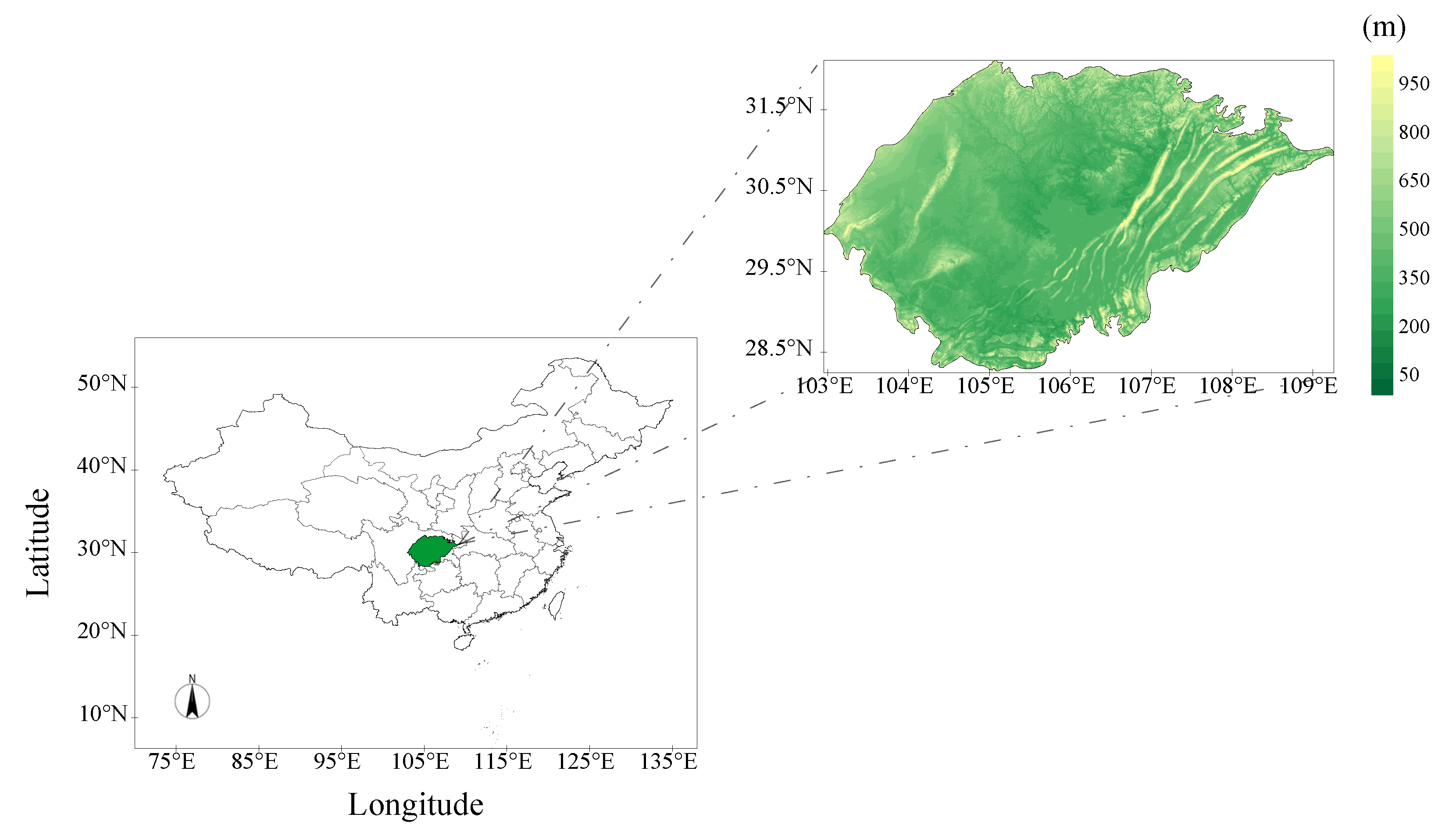

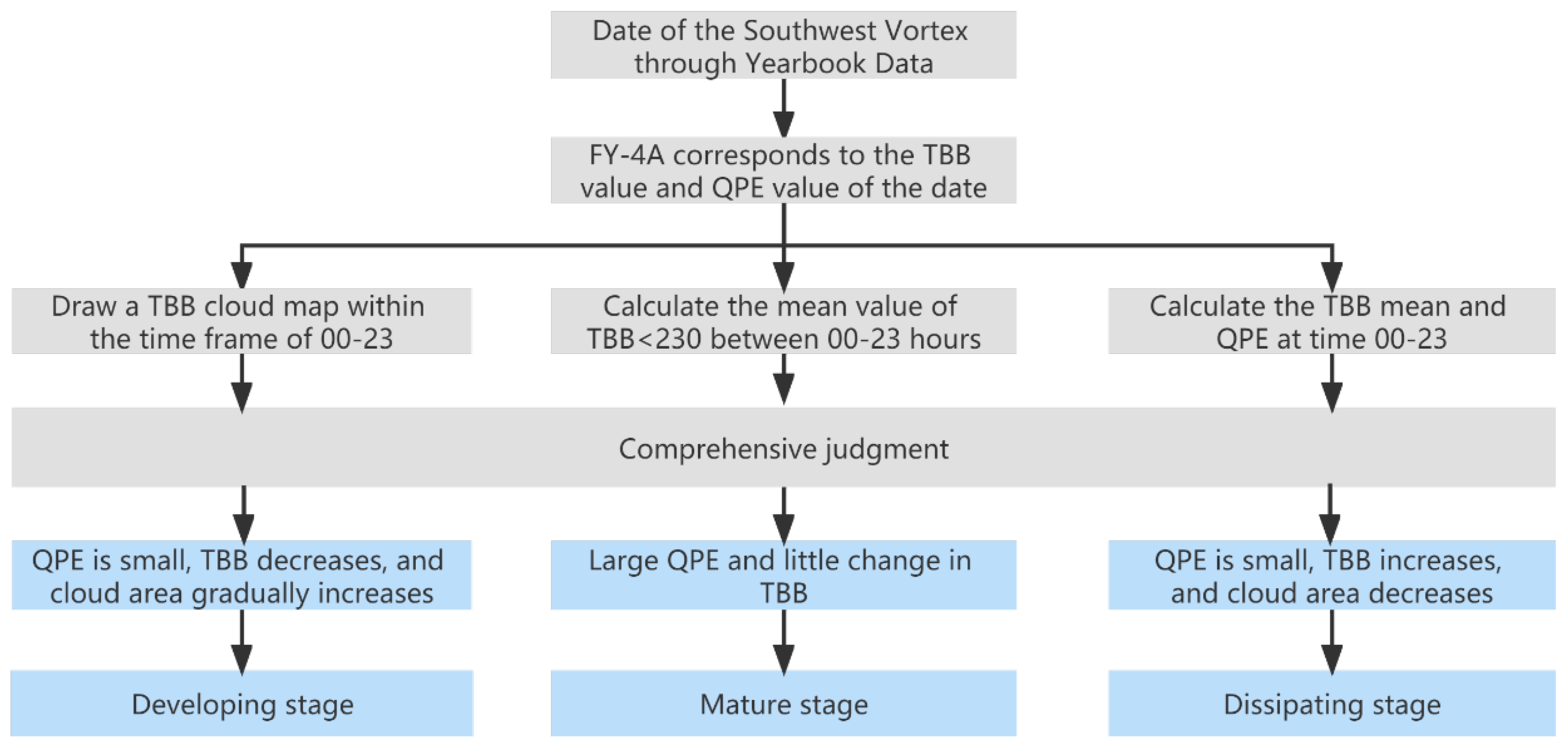
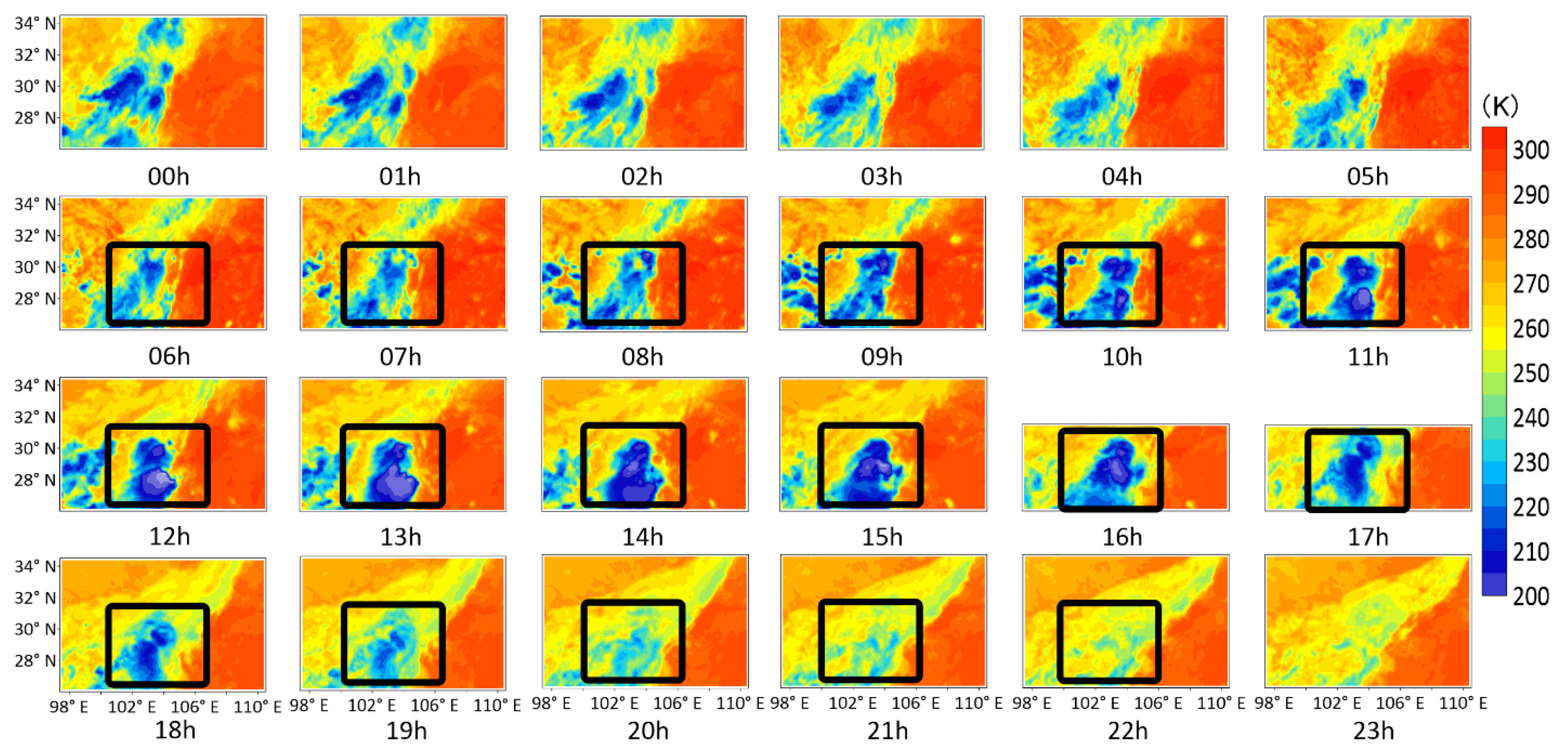
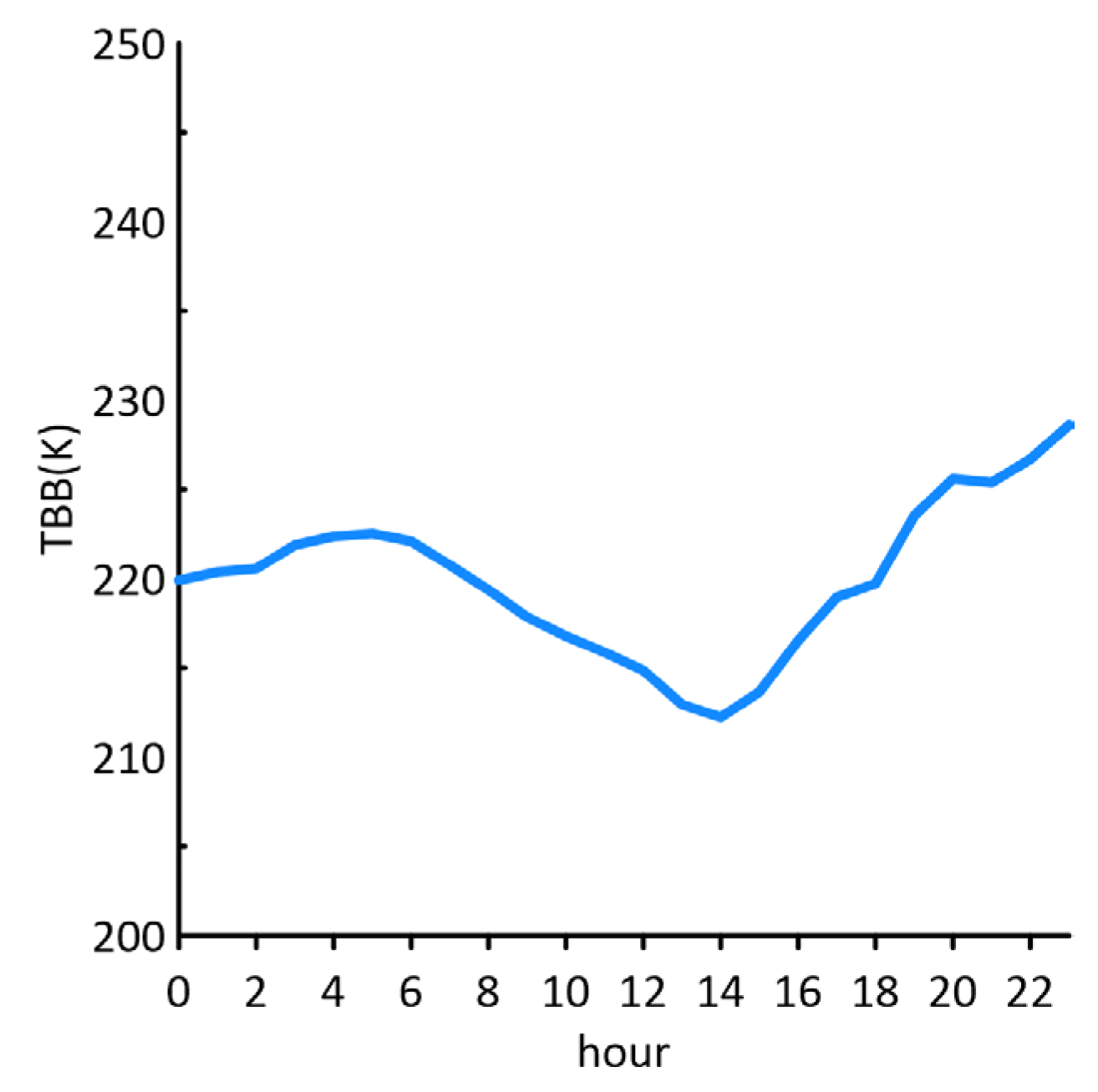

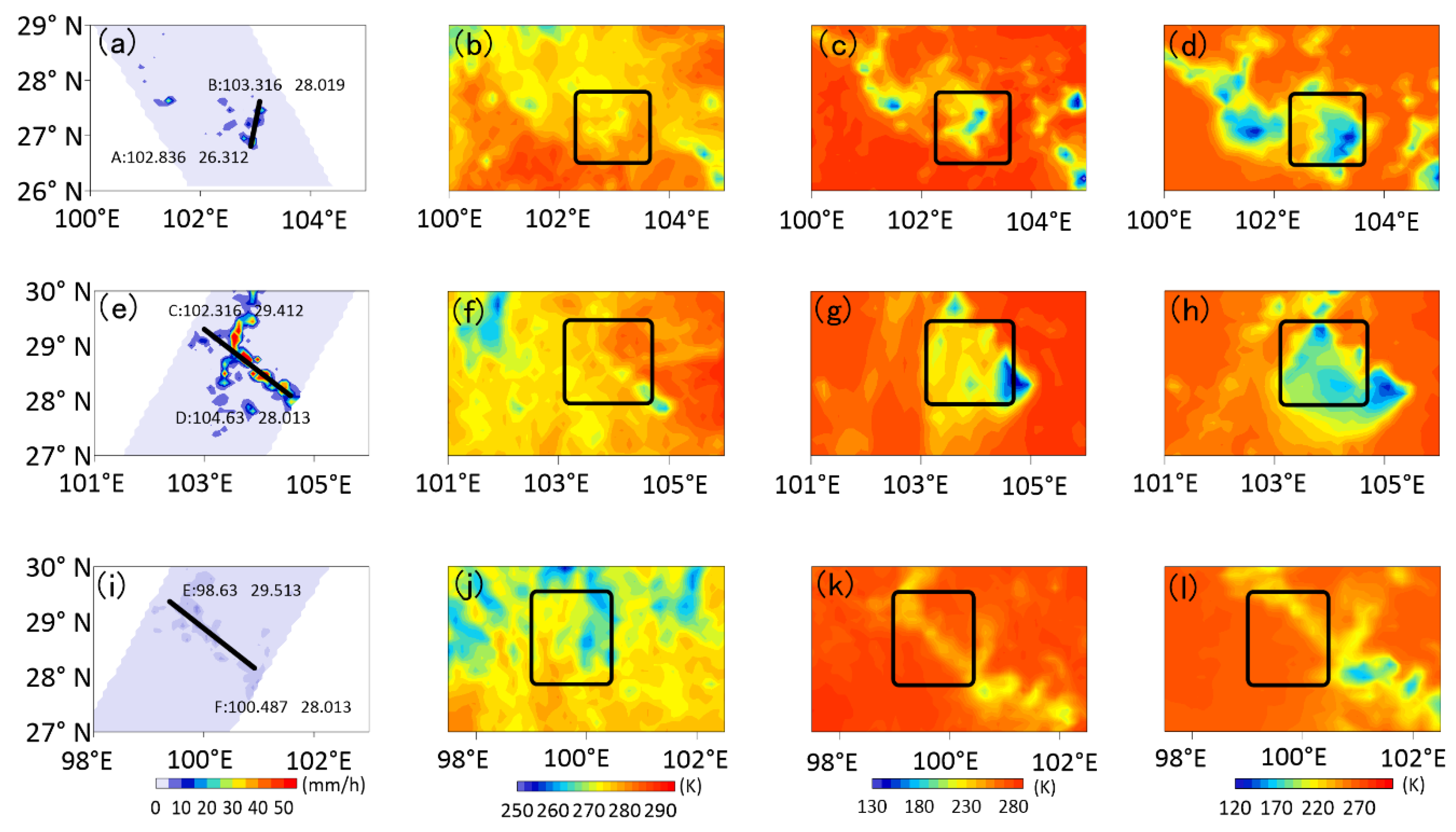
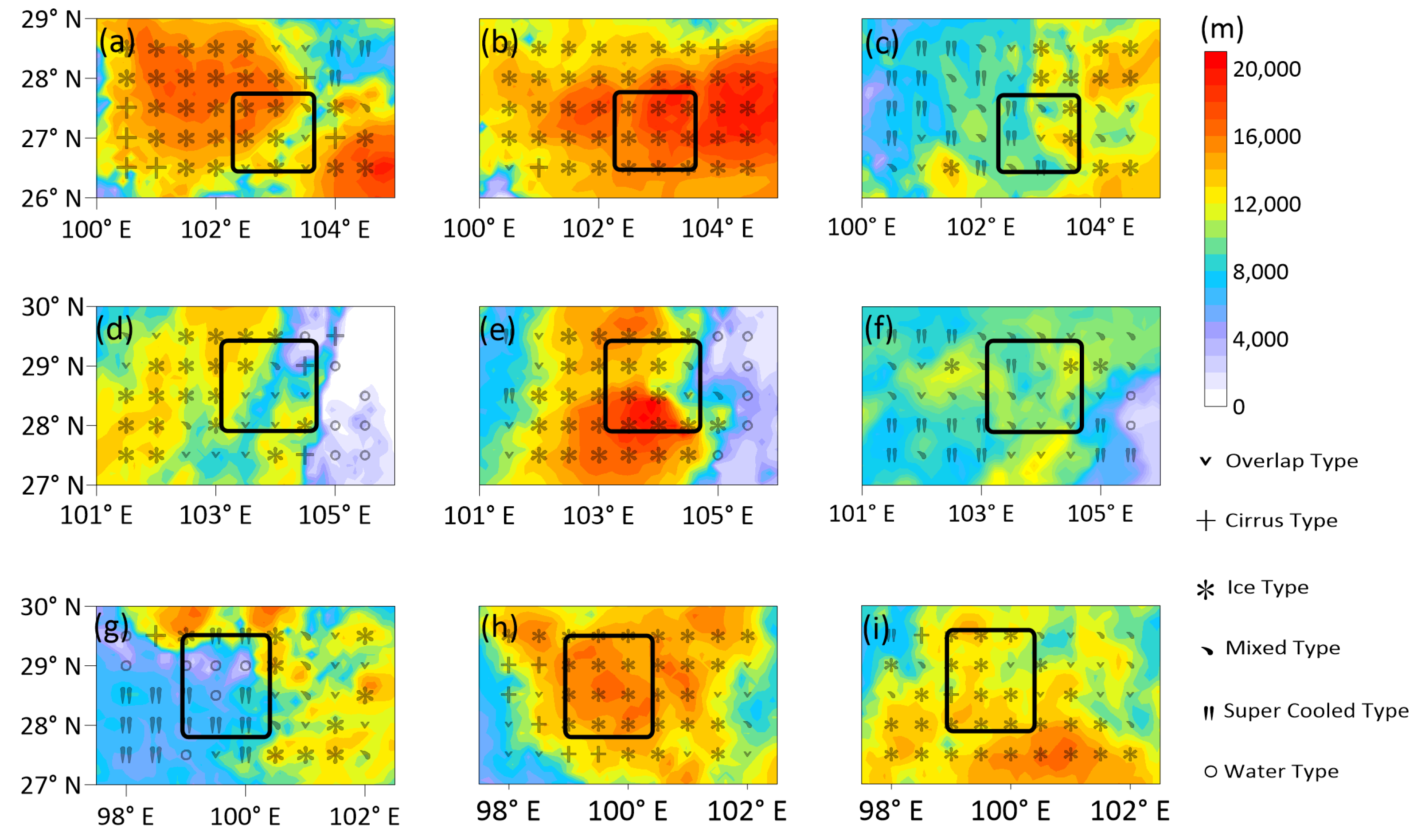

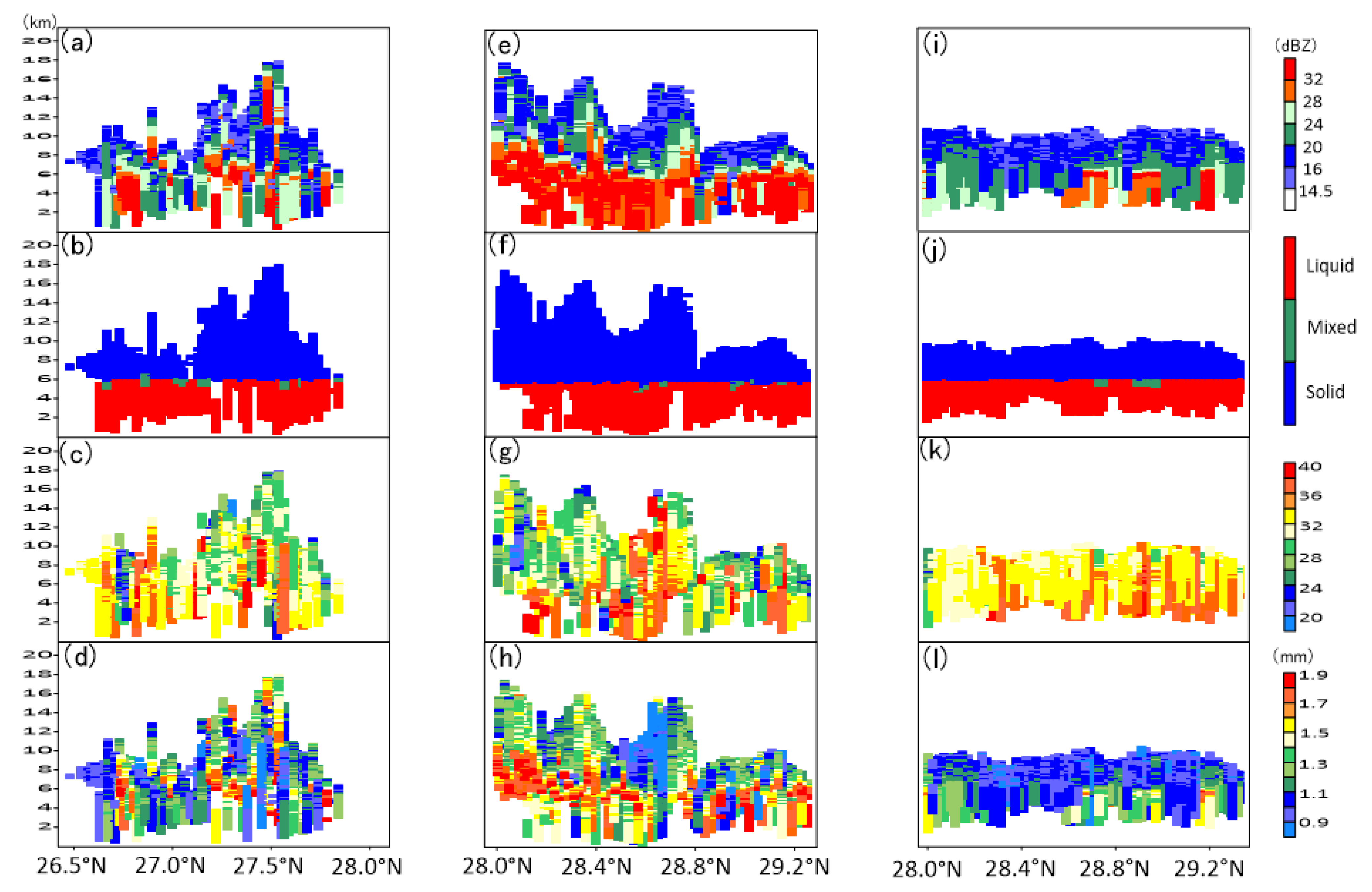


| Instrument | Spatial Resolution/km | Temporal Resolution/min | Scanning Width/km | Start Date | Main Purpose |
|---|---|---|---|---|---|
| AGRI | 4 | 15 | full disk | 12 March 2018 | obtain cloud images and quickly scan minute-level areas |
| DPR | 5 | 90 | 120–245 | 14 March 2014 | obtain more cloud and precipitation particle information |
| GMI | 13 | 90 | 885 | 4 March 2014 | measure the amount, size, intensity, and type of precipitation |
| Year | Month | Day | Influence System (700 hPa) | Influence System (850 hPa) |
|---|---|---|---|---|
| 2020 | 6 | 26 | Shear, SWV | Low vortex |
| 2020 | 6 | 29 | SWV | Low vortex |
| 2020 | 7 | 9 | SWV | Inverted trough, Rapid |
| 2020 | 7 | 14 | SWV | Low vortex |
| 2020 | 7 | 15 | SWV | Low vortex |
| 2020 | 7 | 16 | SWV | Low vortex |
| 2020 | 7 | 25 | Shear | Shear, Low vortex |
| 2020 | 7 | 29 | Southwest jet | Low vortex |
| 2020 | 8 | 10 | Southwest jet | Low vortex |
| 2020 | 8 | 11 | SWV | Low vortex |
| 2020 | 8 | 16 | SWV | Southeast airflow, Cyclonic bending |
| 2020 | 8 | 30 | SWV | Low vortex |
| 2020 | 9 | 5 | SWV | Low vortex |
| 2020 | 9 | 9 | Shear line | Low vortex |
| Case | Date (UTC) | Developing Stage | Mature Stage | Dissipating Stage |
|---|---|---|---|---|
| Case 1 | 29 June 2020 | 12:00–19:00 | 20:00–22:00 | 23:00–04:00 (+1 day) |
| Case 2 | 30 August 2020 | 06:00–11:00 | 12:00–15:00 | 16:00–22:00 |
| Case 3 | 16 August 2020 | 08:00–10:00 | 11:00–13:00 | 14:00–18:00 |
| Life Stage | Case | Clear | Water Type | Super cooled Type | Mixed Type | Ice Type |
|---|---|---|---|---|---|---|
| Developing | Case1 | 0.27 | 0.13 | 0.12 | 0.11 | 0.37 |
| Case2 | 0.08 | 0.41 | 0.18 | 0.08 | 0.25 | |
| Case3 | 0.01 | 0.3 | 0.16 | 0.09 | 0.45 | |
| Mature | Case1 | 0.27 | 0.1 | 0.18 | 0.09 | 0.36 |
| Case2 | 0.34 | 0.12 | 0.22 | 0.06 | 0.26 | |
| Case3 | 0.09 | 0.15 | 0.17 | 0.11 | 0.48 | |
| Dissipating | Case1 | 0.15 | 0.23 | 0.28 | 0.07 | 0.28 |
| Case2 | 0.37 | 0.12 | 0.25 | 0.15 | 0.12 | |
| Case3 | 0.15 | 0.11 | 0.12 | 0.16 | 0.47 |
| Heigh/km | Life Stage | dBNW | Dm/mm |
|---|---|---|---|
| 0–2 | Developing | 33.59 | 1.33 |
| Mature | 35.94 | 1.38 | |
| Dissipating | 28.57 | 1.31 | |
| 2–6 | Developing | 32.53 | 1.32 |
| Mature | 34.12 | 1.42 | |
| Dissipating | 33.48 | 1.18 | |
| 6–20 | Developing | 30.33 | 1.28 |
| Mature | 31.14 | 1.28 | |
| Dissipating | 32.61 | 1.03 |
Disclaimer/Publisher’s Note: The statements, opinions and data contained in all publications are solely those of the individual author(s) and contributor(s) and not of MDPI and/or the editor(s). MDPI and/or the editor(s) disclaim responsibility for any injury to people or property resulting from any ideas, methods, instructions or products referred to in the content. |
© 2023 by the authors. Licensee MDPI, Basel, Switzerland. This article is an open access article distributed under the terms and conditions of the Creative Commons Attribution (CC BY) license (https://creativecommons.org/licenses/by/4.0/).
Share and Cite
Xiang, J.; Wang, H.; Li, Z.; Bu, Z.; Yang, R.; Liu, Z. Case Study on the Evolution and Precipitation Characteristics of Southwest Vortex in China: Insights from FY-4A and GPM Observations. Remote Sens. 2023, 15, 4114. https://doi.org/10.3390/rs15164114
Xiang J, Wang H, Li Z, Bu Z, Yang R, Liu Z. Case Study on the Evolution and Precipitation Characteristics of Southwest Vortex in China: Insights from FY-4A and GPM Observations. Remote Sensing. 2023; 15(16):4114. https://doi.org/10.3390/rs15164114
Chicago/Turabian StyleXiang, Jie, Hao Wang, Zhi Li, Zhichao Bu, Rong Yang, and Zhihao Liu. 2023. "Case Study on the Evolution and Precipitation Characteristics of Southwest Vortex in China: Insights from FY-4A and GPM Observations" Remote Sensing 15, no. 16: 4114. https://doi.org/10.3390/rs15164114
APA StyleXiang, J., Wang, H., Li, Z., Bu, Z., Yang, R., & Liu, Z. (2023). Case Study on the Evolution and Precipitation Characteristics of Southwest Vortex in China: Insights from FY-4A and GPM Observations. Remote Sensing, 15(16), 4114. https://doi.org/10.3390/rs15164114







